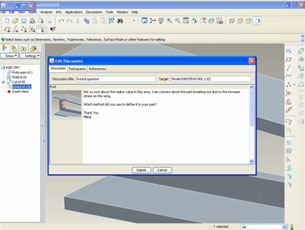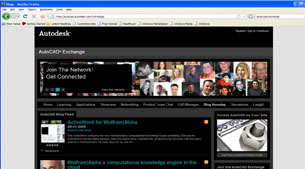Latest News
May 21, 2009
By Kenneth Wong
If you need to reach Jeremiah Owyang, a senior analyst at Forrester, you could try emailing him. But my guess is, he prefers to be contacted via Facebook or Twitter. After all, his area of expertise is social computing, which encompasses online communities, social networks, and blogging, among others. Boasting more than 43,000 followers, Owyang is Twitter’s equivalent of a celebrity (Twitterlebrity). Clearly, his wisdom is appreciated.
In April, Forrester released Owyang’s report titled “The Future Of The Social Web.” In the executive summary, Owyang observes, “Socially connected consumers will strengthen communities and shift power away from brands and CRM (customer relationship management) systems; eventually this will result in empowered communities defining the next generation of products.”
 Fig 1: Vuuch, currently in beta, is an add-on that lets you initiate design discussions right from the CAD modeling environment. |
Traditionally, new product development took place behind closed doors, away from the prying eyes of the public. The shape of a new coffeepot or a snowmobile will mostly be determined by a small committee, then refined as needed based on focus groups’ reactions to early prototypes. The target consumers’ input and approval are seldom sought. By the time the product ships, its fate—be it success or failure—is already sealed.
Home to more than 200,000,000 active members, Facebook is quite possibly the largest focus group anyone has ever assembled. Its community also represents a cross-section of the global consumers who will render the final verdict on your product. So incorporating them into the feedback loop is essential. It’s better to find out early if the new bubblegum-colored digital cameras will be a hit or a miss among the 20-somethings they’re supposed to attract. To do this, you could recruit about a dozen of them for a focus group. Or you could upload a series of 3D renderings and animation clips on Facebook and YouTube, then monitor their reactions. The social networking crowd is anything but shy; they’ll share their feelings in the comments and the thumbs-up/thumbs-down votes.
 Fig 2. Populated with video clips, interviews, discussion forums, and blog entries, AutoCAD Exchange is a media-rich user community designed to appeal to the Web 2.0 generation. |
In his blog, Owyang points out, “Your enterprise systems will need to connect to the social Web. Social networks and their partners are quickly becoming a source of customer information and lead generation beyond your CRM system. CMS (Content Management) systems will need to inherit social features—pressure your vendors to offer this, or find a community platform.”
The Web 2.0 Gold RushCurrently, few CAD or PLM packages are designed to mine the nuggets of wisdom buried in social networks. But the rush is on, spawning several pioneering efforts in this direction. In March, PTC launched the Social Product Development blog. Robin Saitz, one of the regular contributors to this blog, writes, “Social computing is here to stay and I think product development is ripe to take advantage of this new way of working.”
If you use PTC’s Pro/ENGINEER or Dassault Systemes’ SolidWorks, you can now initiate collaboration sessions right from your CAD modeling environment with a plug-in called Vuuch, from a startup by the same name. Billed as a tool for design discussions, Vuuch is the brainchild of Chris Williams, former CEO of Seemage (acquired by Dassault Systemes in October 2007).
Describing the plug-in on its home page, Vuuch states, “Your product is organized with a Bill of Material (BOM), but your design discussions are lost in your in-box. Vuuch organizes your design discussions by associating them to your product design.”
To extend the design discussion beyond the engineering group, Vuuch now plans to add features that let you post inquiries to public forums like www.3dcadforums.com, www.eng-tips.com, and other popular peer-to-peer sites. The company also plans to offer Vuuch’s API to the developers community, hoping to encourage others to create personal widgets that plug into blogs and social networks.
Meanwhile, Dassault Systemes (DS) and its rival Autodesk began cultivating their own customer communities, incorporating features found on Facebook, MySpace, and YouTube. Outlining “A New Agenda for the DS Go-to-Market Model,” Dassault Systemes describes its 3dvia.com portal as “a platform that enables professional and amateur end users to imagine, create, and share the experience of 3D designs, videos, and animations online using such free-of-charge products as 3DVIA Shape. In the longer term, 3dvia.com will host DS’s own customers’ 3D applications and make them available to other customers, thereby seeding the market with compelling 3D experiences through social network techniques.”
Autodesk launched its AutoCAD Exchange portal in March, populating the site with video tutorials, discussion forums, user profiles, and image galleries. With mechanisms allowing users to weigh in on new versions of Autodesk products still in development, the site serves as a direct link between CAD users and developers.
Jim Brown, founder and president of Tech-Clarity, ponders the difference between traditional collaboration and social networking. The purpose of the latter, he says, is “discovering new people and ideas that can further your product innovation and engineering efforts … ]It] includes leveraging what some call ‘weak links,’ which are people that are in your extended network that you don’t know well enough to know what they know.”
Prepare to be TransparentInviting the crowd on social networks into product development also means dispensing with some of the control over your intellectual property (IP). “Crowd-sourcing,” or involving the general public into the brainstorming process, is a double-edged sword. Soliciting people’s feedback on your latest toaster design in a public forum would also expose your design to your competitors.
Perhaps the emergence of social networks will usher in a new attitude towards IP. In his blog, Owyang warns, “Prepare for every Web page and product to be reviewed by your customers and seen by prospects—even if you choose not to participate.”
For more on social networks’ impact on engineering, read:
Vuuch: The Marriage of Social Media and Product Design
Product Development in the Post-Twitter Era
Subscribe to our FREE magazine, FREE email newsletters or both!
Latest News
About the Author
Kenneth Wong is Digital Engineering’s resident blogger and senior editor. Email him at [email protected] or share your thoughts on this article at digitaleng.news/facebook.
Follow DE





